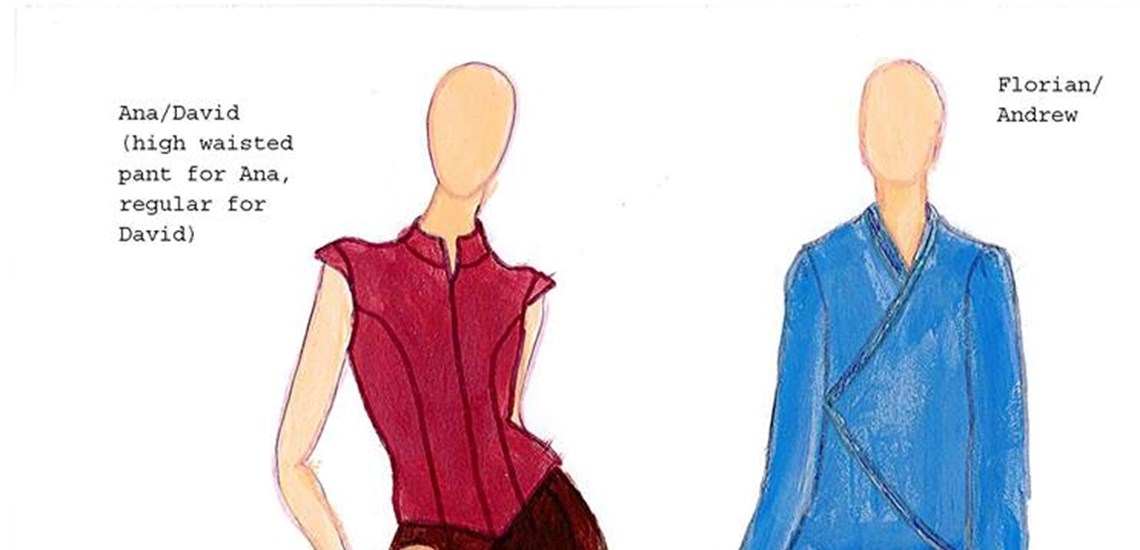Day in the Life: Hubbard Street Wardrobe Technician

July 13, 2018
By: Katie Griffiths
Day in the Life: Hubbard Street Wardrobe Supervisor
On stage, the audience gets the pleasure of not only witnessing the talents and skill of the dancers and choreographers, but also the costume craftsmanship that goes on behind-the-scenes. Jenni Schwaner Ladd, Wardrobe Supervisor, provides us with a firsthand account of what it’s like to work as a costume technician at Hubbard Street.
How long does it take to make each costume?
“It depends on the difficulty of the design. Some pieces are simple, leotard-based designs and we have plenty of patterns already drafted for that, so we don't need to come up with a new one. If it's a different shape or style from something we've made before, our draper will often have to start from scratch and develop a whole new pattern to work from, and that takes more time.”
Elliot Hammans and Jacqueline Burnett in A Picture of You Falling by Crystal Pite. Photo by Todd Rosenberg.
What costume pieces are most difficult to make?
“I think if you asked each of our costume technicians that question, you'd get different answers! I know some of them find pants to be the hardest to fit and construct. It becomes especially complicated when working with fabrics that don't have much stretch in them. You have to put in gussets and inserts to make sure the dancers are able to have maximum movement. One analogy I like to use is that theatre costumes are like basic math, because they are relatively static; opera costumes are more like algebra, because they need to be a little larger than life (like opera itself), but dance costumes are advanced calculus because of the movement involved. Dancers are athletes as well as artists, so you really need to think about fabric choices, line, and structure. The costumes have to hold up under some fairly rigorous physical movement. And, of course, repeated launderings!”
Craig D. Black Jr. and Alicia Delgadillo in Silent Ghost by Alejandro Cerrudo. Photo by Cheryl Mann.
Are all costumes made in-house?
“We try to make as many in-house as we can, but occasionally the job is too large and we call upon other Chicago area costume shops for assistance, such as ThreadLine Studios in Rogers Park, who built our costumes for Crystal Pite's A Picture of You Falling. We’ve also rented costumes from Aspen/Santa Fe Ballet for Silent Ghost, performed during the Spring Series this year. For Decadance/Chicago, there was a mix of in-house building, store-purchased, and an outright purchase from the Batsheva Dance Company in Israel, who originated the piece. That last one had us biting our nails in nervousness – shipping from overseas is always risky and it was getting down to the wire for their arrival. Everyday our production manager, Scott Nelson, would come in and give us a report as to where UPS Tracking showed our costumes were. We told him he needed to create the YouTube series "Where in the World are our Costumes Today?"
Hubbard Street Dance Chicago in Decadance/Chicago by Ohad Naharin. Photo by Todd Rosenberg.
What is the most challenging part of the job; most rewarding?
“The most challenging part of the job is navigating the same tightrope all departments in any arts organization walk - creating the best possible interpretation of the designer and choreographer's vision without going over budget! The most rewarding part has to be the people I work with. From my amazing costume staff; to our wonderfully talented dancers, designers, and choreographers; to our marvelous production crew; and the tirelessness of our fantastic marketing/administration, education, and teaching staff - everyone is so dedicated to the beauty and success of this company to bring dance to not only Chicago but the entire world.”
What/who is your fashion inspiration?
“If I could dress like David Bowie every day, or wear fashions from the mid-1950s and still be comfortable, I'd be a happy woman. I'm fond of certain eras and looks more than particular designers. "Lagenlook," a fashion movement from about 30 years ago, is a favorite of mine that involves a lot of drapey fabrics and handkerchief hems. I am known for my ridiculously huge collection of John Fluevog shoes as well. As far as my design aesthetic for stage goes, I started out as a theatrical designer and designed a lot of pretty crazy musicals. I was known as a costumer of goth-punk aesthetic, with lots of vinyl, glitter, and holographic fabrics. I'm designing for Hubbard Street’s danc(e)volve New Works Festival in December; maybe one of the choreographers will be really into neon, leopard print, stretch velvet...I can always dream.”

Jenni's original sketches for Clan(device) by Alice Klock.
Emilie Leriche and Andrew Murdock in Clan (device) by Alice Klock. Photo by Todd Rosenberg.
Do you design the costumes or get assigned the designs?
“I'll be designing for the Winter Series, and I have designed one previous piece for Hubbard Street, Clan(device) by Alice Klock. Mostly, I assist other artists in realizing their costume designs. Our Spring Series was designed by one of our longtime artists, Branimira Ivanova, and our Fall Series will be designed by another longstanding collaborator, fashion designer and former Hubbard Street dancer, Hogan McLaughlin. Both Brani and Hogan have been in residence in Chicago while their designs have been built in our shop. On other occasions, the designer can't be there and I communicate with them to make sure the concept is being followed to the best of our abilities. For our most recent program, our designer was in Israel, so I asked questions via email and sent fitting photos whenever possible to keep her apprised of our process.
A big thank you to Jenni and the wardrobe team for their tireless artistic contributions to Hubbard Street!
Check back soon for more behind-the-scenes looks are costumes for our upcoming Fall Series, designed by Hogan McLaughlin, and read more about our exciting Season 41 here.



